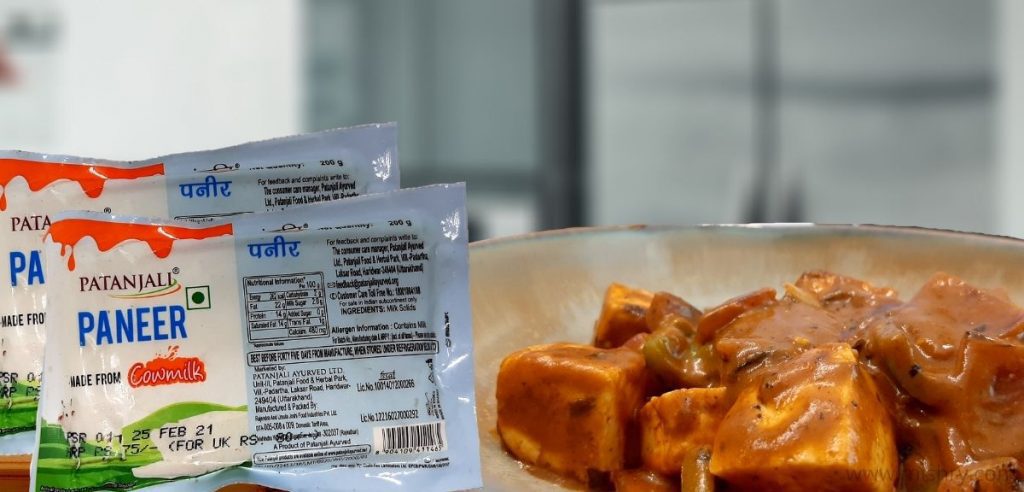Mishry Rating
GOOD!
Summary
Patanjali paneer is made from cow milk. The raw product has a mild hint of sweetness to it. When it is cooked, the paneer becomes soft and it does not become chewy or crumbly.
Patanjali Ayurved Limited was established in 2006, which marked its entry into the FMCG sector. From Ayurvedic medicines to health care products, Patanjali also started manufacturing natural food products like muesli, atta, oil, honey, sugar, and even noodles.
Recently, Patanjali added packaged paneer to its range of products.
We ordered the 200-gm pack of the same to determine if the Patanjali Paneer has the same freshness and softness as the paneer from a local dairy.
Taste, odor, and color are some of the features we talk about in detail in both the raw and post-cooking stage in our Patanjali Fresh Paneer review.
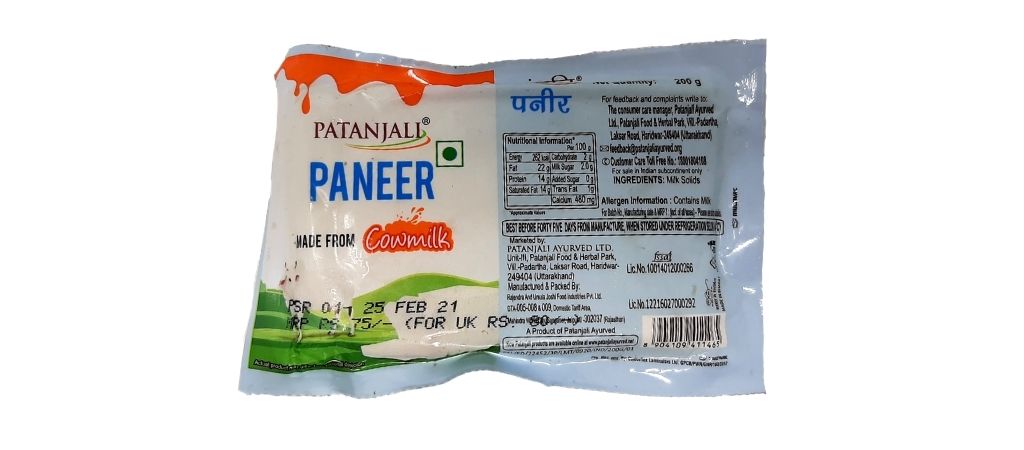
Patanjali’s paneer is made with cow milk. When raw, it has a hint of sweetness to it and post cooking the paneer, it absorbs the gravy well.
MRP: Rs. 75*
Net Weight: 200 grams
- *Price at the time of review
Table of Contents
Patanjali Paneer – Everything You Need To Know
The Patanjali Natural Paneer is made using 100% fresh cow’s milk. Paneer in most Indian homes is made by using lemon or vinegar. Does Patanjali Paneer also use one of these ingredients?
We were curious to know the taste, texture, softness, price, whether it would retain its shape, and other such basic yet significant parameters.
1. Ingredients
Milk solids are the base ingredient used in the Patanjali Paneer. A citrus fruit like lemon or vinegar has traditionally been used for the curdling process. However, it is not mentioned on the pack what specifically was used to curdle the milk.
2. Moisture
When we checked the Patanjali Paneer straight out of the pack, we felt it was a little on the harder side.
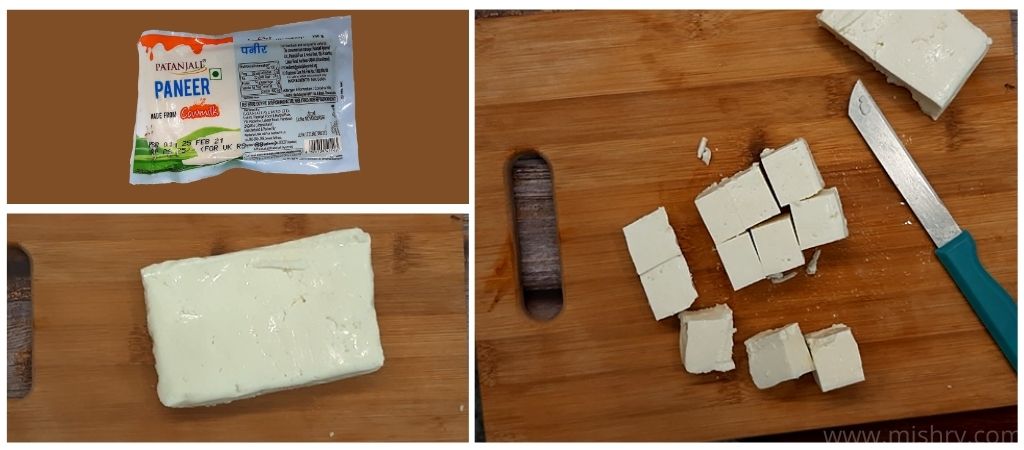
3. Odor
The Patanjali natural paneer had a delectable milky aroma. There wasn’t any sour/foul smell. This indicated that the paneer was fresh.
4. Texture & Color
When we first opened the pack, we observed that the Patanjali paneer had an off-white color. It did not feel very oily (this could result from the type of milk used).
On the creaminess scale, we rate Patanjali Paneer as average. When we tried cutting a piece, we noticed this block to be somewhat crumbly.
As we cooked this paneer, the shape remained intact. The paneer did not break or become incredibly soft.
We cooked the Patanjali paneer in a gravy. Post-cooking, the paneer did become a little softer as compared to when we tasted it raw. Once cooked, the texture was quite good, considering this is a packaged paneer. The paneer didn’t feel chewy or crumbly during the tasting.
5. Taste
When we tasted the Patanjali natural paneer raw, it had a very mild sweetness to it. Post-cooking, the paneer absorbs the flavor of the gravy well. This is one of the things you want when you cook paneer.
6. Price
The price of paneer differs from place to place. Your local dairy may have a different range as compared to someone else’s. The price majorly depends on factors like the quality of the milk used, its fat content, the demand for paneer from that dairy, etc.
Comparing this to other packaged paneer brands in the market, we found that the rate of Patanjali Paneer is similar to its competitors. The 200-gm block can cost you around Rs 75-80.
7. Packaging
The 200-gm block of Patanjali paneer comes in a sealed plastic pack. Half of the pack has the nutritional label with the manufacturing and packaging details and ingredients and the shelf life.
8. Shelf Life
The Patanjali paneer has a shelf life of 45 days when it is stored under refrigeration.
9. Nutrition Facts
The Patanjali paneer has 305 kcals per 100 grams. Per 100 grams, the fat content is 25 grams, and the protein is 18 grams. These are the typical values. You get 2 grams of carbohydrates from 100 grams of Patanjali Paneer.
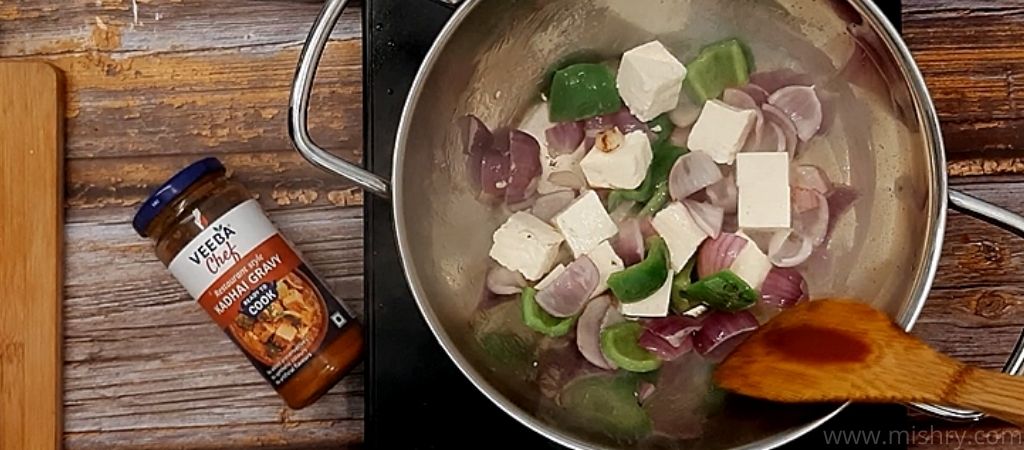
| Parameters | Patanjali Paneer |
| Price | Rs 75 for 250 grams |
| Ingredients | Milk solids |
| Flavor | Raw- slightly sweet
Post-cooking- absorbs flavors of the gravy well |
| Texture | Raw- comparatively hard
Post-cooking- softer, but not breaking or crumbly |
| Color | Raw- off white |
| Shelf Life | 45 days when stored under refrigeration |
Patanjali Fresh Paneer – Detailed Review
Our Patanjali Paneer review found that the paneer has a sweet taste and is slightly on the stiffer side when it is uncooked.
Post-cooking, we noticed it imbibes the flavors and color of the gravy well. In addition to this, it did not become too soft or break into tiny pieces during cooking.
When we tasted it once the dish was ready, we observed how the paneer had become a little soft compared to what it was before.
It doesn’t taste like a packaged product. Patanjali Paneer did not feel chewy or rubbery. We also found a large quantity of whey in this pack.
Whey is the bi-product formed when milk is converted into paneer. During the curdling process, milk is separated into two states. One is the semi-solid form that is kept under a heavyweight and made into a block of paneer. The liquid that is left behind has a light green color and is called whey.
Did you know: Liquid whey is further processed heavily to produce whey powder and isolate protein powders. Isolate protein powders undergo a lot of processing and are safe for lactose-intolerants too.
The liquid whey can be used to curdle the milk instead of lemon or vinegar.
Alternately, it can also be used to knead doughs or consumed as a mid-day beverage with a pinch of salt.
Features
- The 250-gm block of Patanjali Paneer is available in the Rs 75-80 range. Compared to other brands or paneer sold at a dairy, this is a value-for-money product.
- Patanjali Paneer tastes mildly sweet when tasted uncooked.
- It retains the shape throughout.
- Some change in texture was noticed before and after cooking.
- The block of paneer could be easily cut into pieces, it was only slightly crumbly.
Pros
- The Patanjali Paneer absorbs flavors well.
- It holds its shape during and after cooking.
- The texture of the paneer becomes softer once cooked.
- Patanjali Paneer does not have a chewy or rubbery texture, a common experience with packaged paneer.
Cons
- Upon raw consumption, it felt thick and dense. (This is for people who like to pick and eat raw pieces of paneer from the fridge or add paneer chunks to desi-salads.
Best Suited For
If you think the process of manually making paneer is tiresome, this product by Patanjali could be an acceptable alternative.
If there are not many options available close to where you live, in terms of a dairy selling fresh paneer, the Patanjali Paneer is something you could consider.
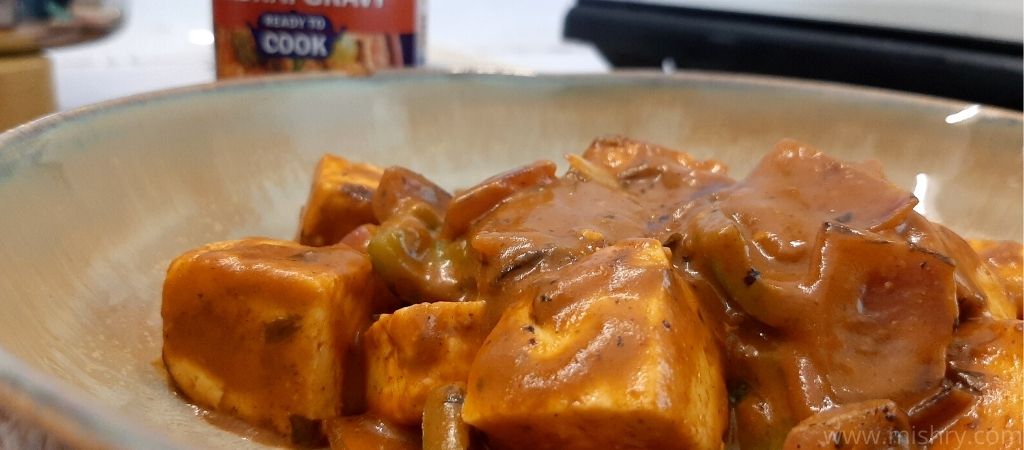
Frequently Asked Questions
Here are some interesting FAQs on Patanjali paneer
1. Can Patanjali Paneer be consumed daily?
Everything when consumed in moderation is fine.
2. Can Patanjali Paneer be eaten raw?
Yes, Patanjali Paneer can be eaten raw as well as added to gravies.
3. How to store Patanjali Paneer?
You are recommended to store the pack in a refrigerator.
4. Can I buy Patanjali Paneer online?
Yes, it is available on Big Basket as well as Amazon.
5. What is the protein content of Patanjali Paneer?
You get 18 grams of protein per 100 grams of Patanjali Paneer.
Final Words
Hope you enjoy reading the detailed review of the Patanjali Paneer where we aimed to answer the most common questions consumers might have.
We ordered the pack ourselves to produce an authentic review from a buyer’s point of view.
The price, taste, texture in both the before and after cooking stages have been mentioned in detail.
We recommend this because the Patanjali Paneer does not have a rubbery feel like most packaged paneer.
We would also like to know the dish you created using Patanjali Paneer. So if you try this out, share it with us in the comment box down below.
* Food & Beverage is a constantly evolving segment with new products launched daily. Our endeavor here is to help shoppers buy better. If there’s a product you would like us to review tell us by clicking here.
* Our reviews are unbiased and all samples used during the reviews were paid for by us. Read our entire ethics statement here.
* No part of this review is sponsored by any brand. All expenses were borne by us.[/porto_blockquote]

